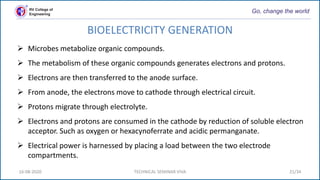The document discusses microbial fuel cells (MFC) for sustainable wastewater treatment. MFCs use microorganisms to convert the chemical energy in organic compounds into electricity. They offer direct conversion of energy in organic matter into electricity with potential for higher efficiency. MFCs can generate electricity while removing over 90% of chemical oxygen demand from wastewater. Several factors like temperature, ionic strength and cathode material affect MFC performance. MFCs show potential for cost-effective and energy-saving wastewater treatment.































![RV College of
Engineering
Go, change the world
REFERENCES
[1] Carlo Santoro, Catia Arbizzani, Benjamin Erable and Ioannis Ieropoulos, “Microbial fuel cells: From fundamentals to applications. A
review,” in Journal of Power Sources, ISSN: 0378-7753, Vol. 356, pp. 225-244, 2017.
[2] Bruce E. Logan, Reneä Rozendal, Uwe Schroder, Jurg Keller, Stefano Freguia, Peter Aelterman, Korneel Rabaey and Bert
Hamelers, “Microbial Fuel Cells: Methodology and Technology,” in Environmental Science and Technology, ISSN: 1520-5851, Vol.
40, pp. 5181-5192, 2006.
[3] Narcis Duteanu, Makarand Ghangrekar, Benjamin Erable and Keith Scott, “Microbial Fuel Cells - An option for wastewater
treatment,” in Environmental Engineering and Management Journal, ISSN: 1069-1087, Vol. 9, 2010.
[4] Deepak Pant, Gilbert Van Bogaert, Ludo Diels and Karolien Vanbroekhoven, “A review of the substrates used in microbial fuel cells
(MFCs) for sustainable energy production,” in Elsevier trans. Bioresource Technology, ISSN 0960-8524, Vol. 101, March 2010, pp.
1533-1543.
[5] Hai-Liang Song, Ying Zhu, Jie Li, “Electron transfer mechanisms, characteristics and applications of biological cathode microbial
fuel cells – A mini review,” in Arabian Journal of Chemistry, ISSN: 1878-5352, Vol. 12, pp. 2236-2243, 2019.
[6] Najafpour, Ghasem, “Microbial Fuel Cells,” in book Biochemical Engineering and Biotechnology published by Elsevier, Vol. 10, pp.
560-567, 2015.
[7] Yusuke Asai, Morio Miyahara, Atsushi Kouzuma and Kazuya Watanabe, “Comparative evaluation of wastewater-treatment microbial
fuel cells in terms of organics removal, waste-sludge production, and electricity generation,” in Springer open trans. Bioresour.
Bioprocess, Vol. 4, 2017.
[8] Veera Gnaneswar Gude, “Wastewater treatment in microbial fuel cells – an overview,” in Journal of Cleaner Production,
ISSN: 0959-6526, Vol. 122, pp. 287-307, 2016.
16-08-2020 TECHNICAL SEMINAR VIVA 32/34](https://image.slidesharecdn.com/microbialfuelcellmfc-200816113655/85/Microbial-fuel-cell-MFC-32-320.jpg)
![RV College of
Engineering
Go, change the world
[9] Venkatesh Chaturvedi and Pradeep Verma, “Microbial fuel cell: a green approach for the utilization of waste for the generation of
bioelectricity,” in Elsevier trans. Bioresource and Bioprocess, Vol. 3, 2016.
[10] Robin M. Allen & H. Peter Bennetto, “Microbial fuel-cells,” article in Biochem-Biotechnol, Vol. 39, pp. 27–40, 1993.
[11] Jessica Li., “An Experimental Study of Microbial Fuel Cells for Electricity Generating: Performance Characterization and Capacity
Improvement,” in Journal of Sustainable Bioenergy Systems, ISSN: 2165-4018, Vol. 3, pp. 171-178, 2013.
[12] Mostafa Rahimnejad, Arash Adhami, Soheil Darvari, Alireza Zirehpour and Sang-Eun Oh, “Microbial fuel cell as new technology for
bioelectricity generation: A review,” in Alexandria Engineering Journal, ISSN: 1110-0168, Vol. 88, 2015.
[13] Muaz Mohd Zaini Makhtar and Vel Murugan Vadivelu, “Membraneless Microbial Fuel Cell: Characterization of Electrogenic
Bacteria and Kinetic Growth Model,” in Journal of Environmental Engineering, ISSN: 1943-7870, Vol. 145, 2019.
[14] Swades K Chaudhuri and Derek R Lovley, “Electricity generation by direct oxidation of glucose in mediatorless microbial fuel
cells,” in article Biotechnol, pp. 1229-1232, 2003.
[15] A. G. Capodaglio, D. Molognoni, E. Dallago, A. Liberal, R. Cella, P. Longoni, and L. Pantaleoni, “Microbial Fuel Cells for Direct
Electrical Energy Recovery from Urban Wastewaters,” article in The Scientific World Journal, Article ID 634738, Vol. 2013,
2013.
[16] Government Regulations for Effluents, in IS: 6582‐1971, Bureau of Indian Standards, revised version 2003.
[17] Annual Progress Report (APR) 2017-2018, ENVIS Centre on Control of Pollution Water, Air and Noise, 2018.
[18] Annual Progress Report (APR) 2018-2019, ENVIS Centre on Control of Pollution Water, Air and Noise, 2019.
[19] Overview of Water supply and sewerage System, Bangalore Water Supply and Sewerage Board (BWSSB), 2019.
16-08-2020 TECHNICAL SEMINAR VIVA 33/34](https://image.slidesharecdn.com/microbialfuelcellmfc-200816113655/85/Microbial-fuel-cell-MFC-33-320.jpg)
